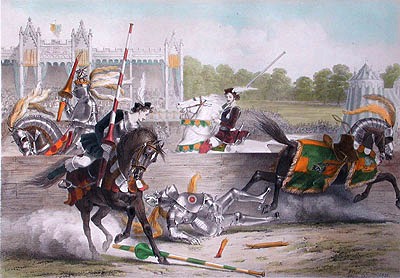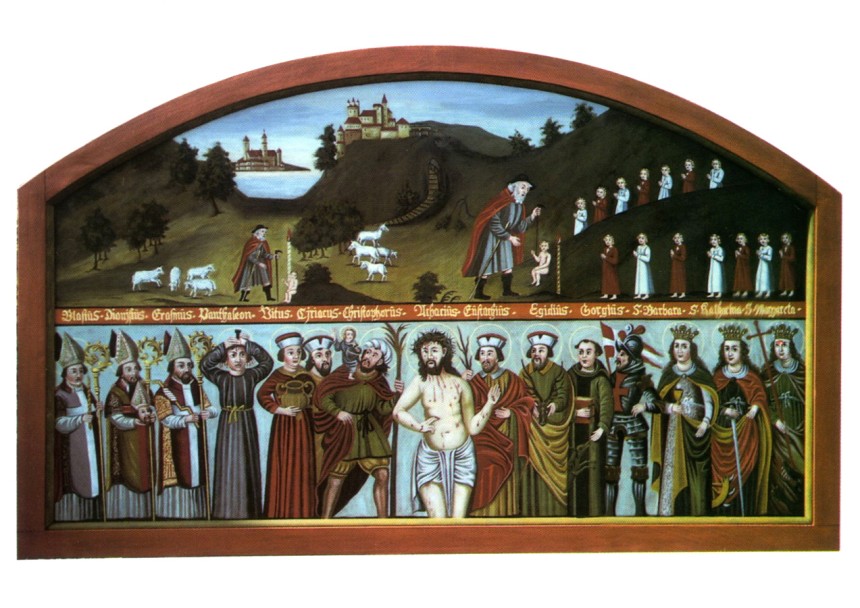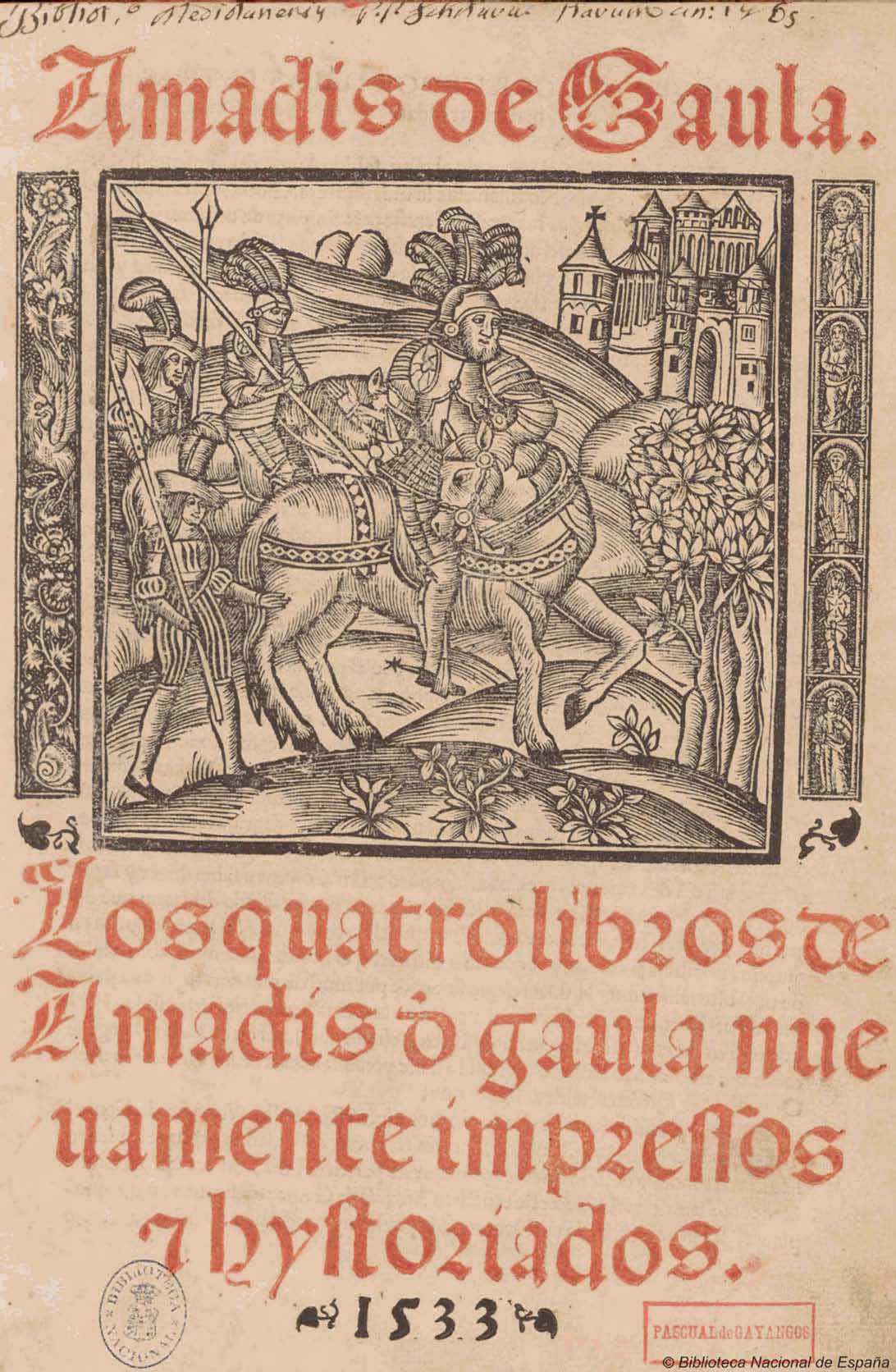|
Seven Champions Of Christendom
The Seven Champions of Christendom is an epithet referring to St. George, St. Andrew, St. Patrick, St. Denis, St. James Boanerges, St. Anthony the Lesser, and St. David. They are the patron saints of, respectively, England, Scotland, Ireland, France, Spain, Portugal, and Wales. The champions were depicted in Christian art and folklore in Great Britain as heroic warriors, most notably in a 1596 book by Richard Johnson titled ''Famous Historie of the Seaven Champions of Christendom''. Richard Johnson was entirely responsible for grouping the seven together, for their epithet, and for most of their adventures in his book. Johnson's book was subsequently rewritten in modern English by W. H. G. Kingston. Legend often portrays God sending James to the Battle of Clavijo to fight against the Moors, while George is usually thought of as being a knightly dragon-slayer. The legend of Patrick casting all of the serpents out of Ireland is also quite famous. While the stories of each of th ... [...More Info...] [...Related Items...] OR: [Wikipedia] [Google] [Baidu] |
Saint Denis Of Paris
Denis of Paris was a 3rd-century Christian martyr and saint. According to his hagiographies, he was bishop of Paris (then Lutetia) in the third century and, together with his companions Rusticus and Eleutherius, was martyred for his faith by decapitation. Some accounts placed this during Domitian's persecution and incorrectly identified StDenis of Paris with the Areopagite who was converted by Paul the Apostle and who served as the first bishop of Athens. Assuming Denis's historicity, it is now considered more likely that he suffered under the persecution of the emperor Decius shortly after AD250. Denis is the most famous cephalophore in Christian legend, with a popular story claiming that the decapitated bishop picked up his head and walked several miles while preaching a sermon on repentance. He is venerated in the Catholic Church as the patron saint of France and Paris and is accounted one of the Fourteen Holy Helpers. A chapel was raised at the site of his burial by a l ... [...More Info...] [...Related Items...] OR: [Wikipedia] [Google] [Baidu] |
William Henry Giles Kingston
William Henry Giles Kingston (28 February 1814 – 5 August 1880), often credited as W. H. G. Kingston, was an English writer of boys' adventure novels. Life William Henry Giles Kingston was born in Harley Street, London on 28 February 1814. He was the eldest son of Lucy Henry Kingston (d.1852) and his wife Frances Sophia Rooke (b.1789), daughter of Sir Giles Rooke, Judge of the Court of Common Pleas. Kingston's paternal grandfather John Kingston (1736–1820) was a Member of Parliament who staunchly supported the Abolition of the Slave Trade, despite having a plantation in Demerara. His father Lucy entered into the wine business in Oporto, and Kingston lived there for many years, making frequent voyages to England and developing a lifelong affection for the sea. He was educated at Trinity College, Cambridge and afterwards entered his father's wine business, but soon indulged in his natural bent for writing. His newspaper articles on Portugal were translated into Portuguese, a ... [...More Info...] [...Related Items...] OR: [Wikipedia] [Google] [Baidu] |
Edward Henry Corbould
Edward Henry Corbould, R.I. (5 December 1815, in London – 18 January 1905, in London) was a British artist, noted as a historical painter and watercolourist. Life Born in London, he was son of Henry Corbould and grandson of Richard Corbould, both painters. He was a pupil of Henry Sass, and a student at the Royal Academy. In 1842 his watercolour of ''The Woman taken in Adultery'' was purchased by Albert, Prince Consort, and nine years later he was appointed instructor of historical painting to the Royal Family. He continued for twenty-one years teaching its members.'' Dictionary of National Biography'', Corbould, Edward Henry (1815–1905), water-colour painter, by A. M. Hind. Published 1912. Corbould married three times: #On 28 September 1839 to Fanny Jemima (died 1850), daughter of the engraver Charles Heath, by whom he had three daughters, one of whom, Isabel Fanny (Mrs. G. H. Heywood), has two daughters who are artists, Mrs. Eveline Corbould-Ellis and Mrs. Weatherley; ... [...More Info...] [...Related Items...] OR: [Wikipedia] [Google] [Baidu] |
Nine Worthies
The Nine Worthies are nine historical, scriptural, and legendary men of distinction who personify the ideals of chivalry established in the Middle Ages, whose lives were deemed a valuable study for aspirants to chivalric status. All were commonly referred to as 'Princes', regardless of their historical titles. In French they are called ''Les Neuf Preux'' or "Nine Valiants", giving a more specific idea of the moral virtues they exemplified: those of soldierly courage and generalship. In Italy they are ''i Nove Prodi''. The Nine Worthies include three pagans (Hector, Alexander the Great and Julius Caesar), three Jews (Joshua, David and Judas Maccabeus) and three Christians (King Arthur, Charlemagne and Godfrey of Bouillon). Origin They were first described in the early fourteenth century, by Jacques de Longuyon in his ''Voeux du Paon'' (1312). Their selection, as Johan Huizinga pointed out, betrays a close connection with the romance genre of chivalry. Neatly divided into ... [...More Info...] [...Related Items...] OR: [Wikipedia] [Google] [Baidu] |
Fourteen Holy Helpers
The Fourteen Holy Helpers (german: Vierzehn Nothelfer, la, Quattuordecim auxiliatores) are a group of saints venerated together by Roman Catholic Christians because their intercession is believed to be particularly effective, especially against various diseases. This group of ''Nothelfer'' ("helpers in need") originated in the 14th century at first in the Rhineland, largely as a result of the epidemic (probably of bubonic plague) that became known as the Black Death. History of veneration Devotion to the fourteen Holy Helpers began in Rhineland, now part of Germany, in the time of the Black Death. Among the fourteen were three virgin martyrs. A German mnemonic for them says: ''Margaretha mit dem Wurm,'' ''Barbara mit dem Turm,'' ''Katharina mit dem Radl'' ''das sind die drei heiligen Madl.'' ("Margaret with the lindworm, Barbara with the tower, Catherine with the wheel, those are the three holy maids.") As the other saints began to be invoked along with these three vir ... [...More Info...] [...Related Items...] OR: [Wikipedia] [Google] [Baidu] |
Four Holy Marshals
The Four Holy Marshals (''Vier Marschälle Gottes'' or just ''Vier Marschälle'') are four saints venerated in the Rhineland, especially at Cologne, Liège, Aachen, and Eifel. They are conceived as standing particularly close to throne of God, and thus powerful intercessors. Their joint veneration is comparable to that of the Fourteen Holy Helpers, who are also venerated in the Rhineland. They are considered “ marshals of God” and were invoked against diseases and epidemics during the Middle Ages. Evidence of this devotion is testified by documentation dating from 1478; however, the joint devotion of these four saints may have existed earlier. The devotion reached its high point in the fifteenth and sixteenth centuries and diminished by the seventeenth. There were churches dedicated to them at Hüngersdorf, Schleiden, and in the Mariwald. The Four Holy Marshals The four saints are: In terms of protection over animals, Anthony is the patron of pigs, Cornelius ... [...More Info...] [...Related Items...] OR: [Wikipedia] [Google] [Baidu] |
Knights-errant
A knight-errant (or knight errant) is a figure of medieval chivalric romance literature. The adjective '' errant'' (meaning "wandering, roving") indicates how the knight-errant would wander the land in search of adventures to prove his chivalric virtues, either in knightly duels (''pas d'armes'') or in some other pursuit of courtly love. Description The knight-errant is a character who has broken away from the world of his origin, in order to go off on his own to right wrongs or to test and assert his own chivalric ideals. He is motivated by idealism and goals that are often illusory. In medieval Europe, knight-errantry existed in literature, though fictional works from this time often were presented as non-fiction. The template of the knight-errant were the heroes of the Round Table of the Arthurian cycle such as Gawain, Lancelot, and Percival. The quest ''par excellence'' in pursuit of which these knights wandered the lands is that of the Holy Grail, such as in ''Perceval, ... [...More Info...] [...Related Items...] OR: [Wikipedia] [Google] [Baidu] |
Martyr
A martyr (, ''mártys'', "witness", or , ''marturia'', stem , ''martyr-'') is someone who suffers persecution and death for advocating, renouncing, or refusing to renounce or advocate, a religious belief or other cause as demanded by an external party. In the martyrdom narrative of the remembering community, this refusal to comply with the presented demands results in the punishment or execution of an actor by an alleged oppressor. Accordingly, the status of the 'martyr' can be considered a posthumous title as a reward for those who are considered worthy of the concept of martyrdom by the living, regardless of any attempts by the deceased to control how they will be remembered in advance. Insofar, the martyr is a relational figure of a society's boundary work that is produced by collective memory. Originally applied only to those who suffered for their religious beliefs, the term has come to be used in connection with people killed for a political cause. Most martyrs are consid ... [...More Info...] [...Related Items...] OR: [Wikipedia] [Google] [Baidu] |
Middle Ages
In the history of Europe, the Middle Ages or medieval period lasted approximately from the late 5th to the late 15th centuries, similar to the post-classical period of global history. It began with the fall of the Western Roman Empire and transitioned into the Renaissance and the Age of Discovery. The Middle Ages is the middle period of the three traditional divisions of Western history: classical antiquity, the medieval period, and the modern period. The medieval period is itself subdivided into the Early, High, and Late Middle Ages. Population decline, counterurbanisation, the collapse of centralized authority, invasions, and mass migrations of tribes, which had begun in late antiquity, continued into the Early Middle Ages. The large-scale movements of the Migration Period, including various Germanic peoples, formed new kingdoms in what remained of the Western Roman Empire. In the 7th century, North Africa and the Middle East—most recently part of the Eastern Ro ... [...More Info...] [...Related Items...] OR: [Wikipedia] [Google] [Baidu] |
Europe
Europe is a large peninsula conventionally considered a continent in its own right because of its great physical size and the weight of its history and traditions. Europe is also considered a Continent#Subcontinents, subcontinent of Eurasia and it is located entirely in the Northern Hemisphere and mostly in the Eastern Hemisphere. Comprising the westernmost peninsulas of Eurasia, it shares the continental landmass of Afro-Eurasia with both Africa and Asia. It is bordered by the Arctic Ocean to the north, the Atlantic Ocean to the west, the Mediterranean Sea to the south and Asia to the east. Europe is commonly considered to be Boundaries between the continents of Earth#Asia and Europe, separated from Asia by the drainage divide, watershed of the Ural Mountains, the Ural (river), Ural River, the Caspian Sea, the Greater Caucasus, the Black Sea and the waterways of the Turkish Straits. "Europe" (pp. 68–69); "Asia" (pp. 90–91): "A commonly accepted division between Asia and E ... [...More Info...] [...Related Items...] OR: [Wikipedia] [Google] [Baidu] |
Serpent (symbolism)
The serpent, or snake, is one of the oldest and most widespread mythological symbols. The word is derived from Latin ''serpens'', a crawling animal or snake. Snakes have been associated with some of the oldest rituals known to mankind and represent dual expression of good and evil. In some cultures, snakes were fertility symbols. For example, the Hopi people of North America performed an annual snake dance to celebrate the union of Snake Youth (a Sky spirit) and Snake Girl (an Underworld spirit) and to renew the fertility of Nature. During the dance, live snakes were handled, and at the end of the dance the snakes were released into the fields to guarantee good crops. "The snake dance is a prayer to the spirits of the clouds, the thunder and the lightning, that the rain may fall on the growing crops." To the Hopi, snakes symbolized the umbilical cord, joining all humans to Mother Earth. The Great Goddess often had snakes as her familiars—sometimes twining around her sacred staff ... [...More Info...] [...Related Items...] OR: [Wikipedia] [Google] [Baidu] |
Dragon
A dragon is a reptilian legendary creature that appears in the folklore of many cultures worldwide. Beliefs about dragons vary considerably through regions, but dragons in western cultures since the High Middle Ages have often been depicted as winged, horned, and capable of breathing fire. Dragons in eastern cultures are usually depicted as wingless, four-legged, serpentine creatures with above-average intelligence. Commonalities between dragons' traits are often a hybridization of feline, reptilian and avian features. Scholars believe huge extinct or migrating crocodiles bear the closest resemblance, especially when encountered in forested or swampy areas, and are most likely the template of modern Oriental dragon imagery. Etymology The word ''dragon'' entered the English language in the early 13th century from Old French ''dragon'', which in turn comes from la, draconem (nominative ) meaning "huge serpent, dragon", from Ancient Greek , (genitive , ) "serpent, giant s ... [...More Info...] [...Related Items...] OR: [Wikipedia] [Google] [Baidu] |








